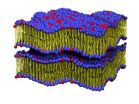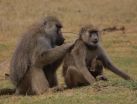(Press-News.org) VIDEO:
Contrary to popular belief, spooning is not always the best sex position for those with a bad back, according to research from the University of Waterloo. For the first time...
Click here for more information.
Contrary to popular belief, spooning is not always the best sex position for those with a bad back, according to new research from the University of Waterloo.
For the first time ever, scientists have successfully documented the way the spine moves during sex and discovered exactly why certain positions are better than others when it comes to avoiding back pain.
"Any family doctor will tell you that couples often ask them how to manage their back pain during and after sex. Many couples will remain celibate because one night of love-making can lead to months of back agony," said Professor Stuart McGill, of Waterloo's Faculty of Applied Health Sciences. "Until now, doctors have never had any hard science to base their recommendations upon."
The pioneering study combined infrared and electromagnetic motion capture systems – like those used in the creation of video games – to track how 10 couples' spines moved when attempting five common sex positions. The findings were used to create an atlas, or set of guidelines, that recommends different sex positions and thrusting techniques based on what movements trigger a patient's pain.
"Before now, spooning was often recommended by physicians as the one position that fit all. But as we've discovered, that is not the case," said Natalie Sidorkewicz, a PhD candidate at Waterloo and lead author on the paper. "Sex positions that are suitable for one type of back pain aren't appropriate for another kind of pain."
The atlas recommends that men who are flexion-intolerant – meaning those whose back pain is made worse by touching their toes or sitting for long periods of time, for example – replace spooning with doggy-style sex. The guide recommends that these men use a hip-hinging motion rather than thrusting with their spines.
"For the first time ever, we now have very solid science to guide clinicians on their recommendations for patients who suffer debilitating back pain, but still want to be intimate," said Sidorkewicz. "This has the potential to improve quality of life – and love-life – for many couples."
According to Statistics Canada, four of every five people will experience at least one episode of disabling low back pain in their lifetime. Up to 84 per cent of men with low back pain and 73 per cent of women report a significant decrease in the frequency of intercourse when suffering back pain.
The study also shed light for the first time on the mechanics of the male orgasm. Electrodes hooked up to the male participants' muscles revealed that it is abdominal and buttock, not back muscles, that are most active during orgasm. Spine motion, on the other hand, varied with the individual. For some males, a drastic increase in flexion or extension was seen, while for others spine motion did not change much at all.
"Many of the back pain patients that we see have told us that they experience elevated levels of pain during orgasm, to the point where they will avoid having one during sex with their partner," said Sidorkewicz. "These initial findings help us to begin to understand what might be provoking their pain during the moment of climax."
A paper documenting male spine movement was published Thursday in the journal Spine. Female findings are expected to be published in the coming months. The next phase of the study will involve recruiting patients with hip pain and additional categories of back pain to further develop the guidelines.
INFORMATION:
Back pain killing your sex life?
Groundbreaking study reveals best positions to save your spine
2014-09-10
ELSE PRESS RELEASES FROM THIS DATE:
US cityscapes show consistent patterns of 'urban evolution'
2014-09-10
Most people think of city landscapes as simpler, diminished versions of the wild forests and free-flowing streams found in remote places. But in a series of studies published Sept. 10, 2014 in a special issue of the journal Biogeochemistry, scientists specializing in urban ecosystems say just the opposite is true. Urban landscapes are more complex than they seem, and from coast to coast these ecosystems can work in surprisingly similar ways, regardless of local conditions. And they have the potential to change quickly – for better or worse – depending on how people manage ...
Study shows that in baboons, as well as humans, social relationships matter
2014-09-10
Elizabeth Archie, Clare Booth Luce Assistant Professor in the Department of Biological Sciences at Notre Dame and colleagues used an incredibly rich data set on the social relationships of wild baboons which was collected on an almost daily basis, year-round, since 1984 by the Amboseli Baboon Research Project. The project, which Archie helps direct, is a long-term study of wild baboons that follows the lives of individual baboons, watching what they do and who they interact with.
"We can tell individual baboons apart by distinct features of their appearance, such as their ...
Teens' neural response to food commercials predicts future weight gain
2014-09-10
Children and adolescents see thousands of food commercials each year and most of them advertise junk foods high in sugar, fat and salt. Yet, we know almost nothing about how all of this food marketing impacts the brain, especially for teens. New research suggests that food commercials "get under the skin" of teens by activating reward regions when they are viewing ads for milk shakes, or burgers, or colas. The bad news for us is that this can result in weight gain and obesity.
In the first prospective longitudinal study to investigate neural response to unhealthy food ...
New research finds that smartphone apps are a useful tool for diet monitoring
2014-09-10
TEMPE, Ariz. (Sept. 10, 2014) - The ability and consistency in monitoring one's diet, but not dietary quality, improves with the use of smartphone applications, according to new research by Arizona State University health scientists published in the latest issue of the Journal of Nutrition Education and Behavior.
Researchers Christopher Wharton, Carol Johnston, Barbara Cunningham and Danielle Sterner at ASU's School of Nutrition and Health Promotion authored the study.
The study compared the effectiveness of a popular smartphone application called "Lose It" for dietary ...
Working during depression can offer health benefits to employees
2014-09-10
The collaborative study between the University Of Melbourne and the Menzies Research Institute at the University of Tasmania is the first to estimate the long-term costs and health outcomes of depression-related absence as compared to individuals who continue to work among employees with depression in Australia.
Lead researcher Dr Fiona Cocker from the Melbourne School of Population and Global Health said a greater understanding of the costs and consequences of both absenteeism and presenteeism would allow for more informed recommendations to be made to the benefit of ...
Researchers watch lipid molecules in motion
2014-09-10
Researchers from Göttingen in collaboration with colleagues from Augsburg have 'filmed' the movement of lipid molecules using an X-ray stroboscope at DESY. In the scientific journal Physical Review Letters, researchers lead by Professor Tim Salditt of the University of Göttingen report that their study offers new insights into the dynamics of biomolecules, which compose materials such as cell membranes. The cell membranes consist of a double layer of lipid molecules; the properties of the membranes are of great interest because they control which substances enter and exit ...
Pain tolerance levels between men and women are similar
2014-09-10
Resilience, a person's ability to overcome adverse circumstances, is the main quality associated with pain tolerance among patients and their adjustment to chronic pain. This is the result of a new study carried out at the University of Málaga that shows that the effect of gender on this ability is not as significant as originally thought.
Over the years a number of clinical trials have shown important gender differences with regard to susceptibility to pain through illness, effectiveness of medications and recovery after anaesthetic. Furthermore, these results coincide ...
UM study finds air pollution harmful to young brains
2014-09-10
MISSOULA, Mont. – Pollution in many cities threatens the brain development in children.
Findings by University of Montana Professor Dr. Lilian Calderón-Garcidueñas, MA, MD, Ph.D., and her team of researchers reveal that children living in megacities are at increased risk for brain inflammation and neurodegenerative changes, including Alzheimer's or Parkinson's disease.
Calderón-Garcidueñas' findings are detailed in a paper titled "Air pollution and children: Neural and tight junction antibodies and combustion metals, the role of barrier breakdown and brain ...
Lady baboons with guy pals live longer
2014-09-10
DURHAM, N.C. –- Numerous studies have linked social interaction to improved health and survival in humans, and new research confirms that the same is true for baboons.
A long-term study of more than 200 wild female baboons from the plains of southern Kenya finds that the most sociable females –- measured by how often they engaged in social grooming relative to their peers -- live two to three years longer than their socially isolated counterparts.
Socializing with males gave females an even bigger longevity boost than socializing with other females, the researchers ...
New study reconstructs mega-earthquakes timeline in Indian Ocean
2014-09-10
MIAMI – A new study on the frequency of past giant earthquakes in the Indian Ocean region shows that Sri Lanka, and much of the Indian Ocean, is affected by large tsunamis at highly variable intervals, from a few hundred to more than one thousand years. The findings suggest that the accumulation of stress in the region could generate as large, or even larger tsunamis than the one that resulted from the 2004 magnitude-9.2 Sumatra earthquake.
Researchers from the University of Miami (UM) Rosenstiel School of Marine and Atmospheric Science and the University of Peradeniya ...
LAST 30 PRESS RELEASES:
Air pollution exposure and birth weight
Obstructive sleep apnea risk and mental health conditions among older adults
How talking slows eye movements behind the wheel
The Ceramic Society of Japan’s Oxoate Ceramics Research Association launches new international book project
Heart-brain connection: international study reveals the role of the vagus nerve in keeping the heart young
Researchers identify Rb1 as a predictive biomarker for a new therapeutic strategy in some breast cancers
Survey reveals ethical gaps slowing AI adoption in pediatric surgery
Stimulant ADHD medications work differently than thought
AI overestimates how smart people are, according to HSE economists
HSE researchers create genome-wide map of quadruplexes
Scientists boost cell "powerhouses" to burn more calories
Automatic label checking: The missing step in making reliable medical AI
Low daily alcohol intake linked to 50% heightened mouth cancer risk in India
American Meteorological Society announces Rick Spinrad as 2026 President-Elect
Biomass-based carbon capture spotlighted in newly released global climate webinar recording
Illuminating invisible nano pollutants: advanced bioimaging tracks the full journey of emerging nanoscale contaminants in living systems
How does age affect recovery from spinal cord injury?
Novel AI tool offers prognosis for patients with head and neck cancer
Fathers’ microplastic exposure tied to their children’s metabolic problems
Research validates laboratory model for studying high-grade serous ovarian cancer
SIR 2026 delivers transformative breakthroughs in minimally invasive medicine to improve patient care
Stem Cell Reports most downloaded papers of 2025 highlight the breadth and impact of stem cell research
Oxford-led study estimates NHS spends around 3% of its primary and secondary care budget on the health impacts of heat and cold in England
A researcher’s long quest leads to a smart composite breakthrough
Urban wild bees act as “microbial sensors” of city health.
New study finds where you live affects recovery after a hip fracture
Forecasting the impact of fully automated vehicle adoption on US road traffic injuries
Alcohol-related hospitalizations from 2016 to 2022
Semaglutide and hospitalizations in patients with obesity and established cardiovascular disease
Researchers ‘listen in’ to embryo-mother interactions during implantation using a culture system replicating the womb lining
[Press-News.org] Back pain killing your sex life?Groundbreaking study reveals best positions to save your spine









